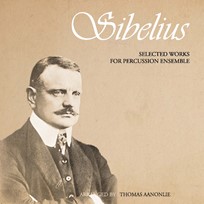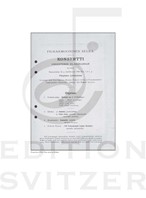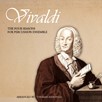
Selected works by Sibelius for percussion ensemble
Composer: Jean Sibelius
Instrument: Percussion Ensemble
Level: Intermediate
Published: 2013
Price: €40.00
Item details
-
Description +
-
Arranged by Thomas Aanonlie
Duration: 20 min.
For my sixth publishing for Edition SVITZER I have arranged five movements for percussion ensemble by the Finnish National Romanticist Jean Sibelius. I have arranged three pieces from his works for piano: “3 Pieces” from 1914 plus ”Berceuse” and his well-known ”Valse Triste” from Kuolema, the play by Arvid Järnefelt.
1. "Berceuse", op. 40, no. 5 (quartet)
glockenspiel, vibraphone & 2 marimbas.
2. "Valse triste", op. 44 (quartet) - music from Arvid Järnefelt´s Drama "Kuolema"
glockenspiel, vibraphone, marimba & timpani.
3. "Etude", op. 76, no. 2 (quartet)
glockenspiel, xylophone, vibraphone and marimba.
4. "Piéce enfantine", op. 76, no. 8 (quartet)
glockenspiel, xylophone, vibraphone and marimba.
5. "Arabesque", op. 76, no. 9 (trio)
glockenspiel, xylophone & marimba.
-
-
Instrumentation +
-
Percussion Ensemble:
1. "Berceuse", op. 40, no. 5 (quartet)
glockenspiel, vibraphone & 2 marimbas.
2. "Valse triste", op. 44 (quartet) - music from Arvid Järnefelt´s Drama "Kuolema"
glockenspiel, vibraphone, marimba & timpani.
3. "Etude", op. 76, no. 2 (quartet)
glockenspiel, xylophone, vibraphone and marimba.
4. "Piéce enfantine", op. 76, no. 8 (quartet)
glockenspiel, xylophone, vibraphone and marimba.
5. "Arabesque", op. 76, no. 9 (trio)
glockenspiel, xylophone & marimba.
-
-
About the composer +
-
Jean Sibelius (8 December 1865 – 20 September 1957), was a Finnish composer and violinist of the late Romantic and early-modern periods. He is widely recognized as his country's greatest composer and, through his music, is often credited with having helped Finland to develop a national identity during its struggle for independence from Russia.
-
-
Reviews +
-
Review (Percussive Notes, July 2016)
Thomas Aanonlie has beautifully arranged five of Jean Sibelius’s works for small percussion ensemble. Originally written for orchestra or piano, these works represent the breadth and depth of Sibelius’s style, including contrasting themes and rich harmonies. Pedagogically these are wonderful pieces for developing ensemble skills and phrasing. These arrangements would have great appeal to programs with varying student abilities. Generally, strong players must play the marimba, vibraphone, and xylophone parts, and intermediate players can play glockenspiel parts. The vibraphone and marimba parts often require four mallets. The technique required of each four-mallet part is mainly chordal and does not require technical mastery. The xylophone and marimba parts in “Etude, op. 76, No. 2,” and “Arabesque” are quite quick and require players with lots of technical and dynamic control.
The arrangement stays very true to the originals with particular attention paid to phrasing, bowing, and articulation. A creative approach to these articulations is needed. For example, at the end of “Berceuse,” an articulated legato is notated. Depending on the experience of the player, quality of instruments, and performance space, a good ear for note length and timbre is necessary for a successful performance.
Because of the limited instrumentation this is a good choice for smaller programs. The score calls for a 5-octave marimba, but a transposition is possible and is mentioned in the performance notes.
—Joe Millea
-
-
Credits +
-
Front Cover graphics and layout: Ronni Kot Wenzell
Translation: Anders Fitje
Engraving: Johan Svitzer
Printed in Copenhagen, Denmark
Copyright © Edition SVITZER
www.editionsvitzer.com
-





